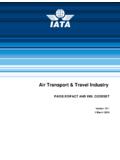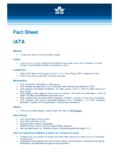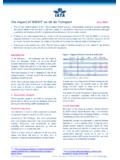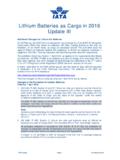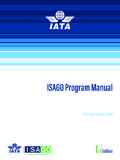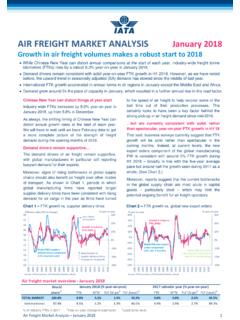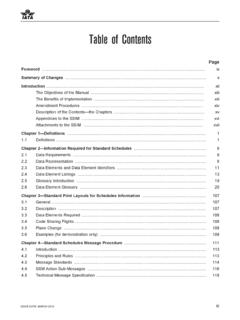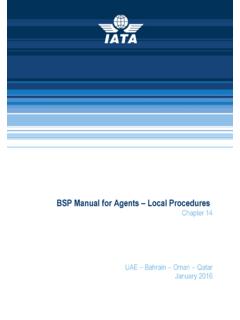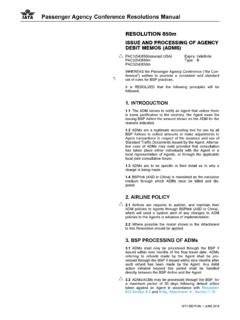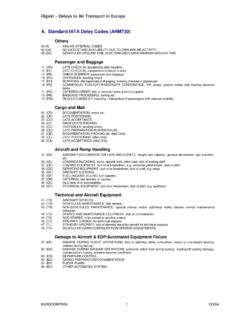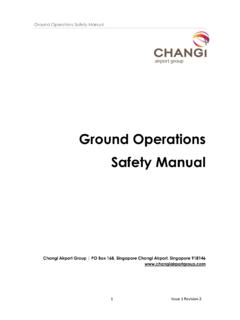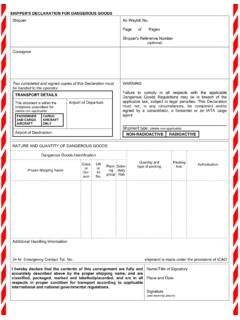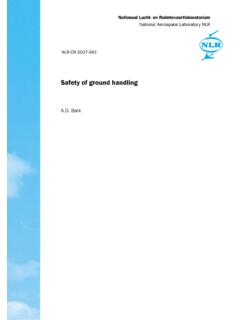Transcription of Airport Service Level Agreement (SLA) Best Practice - IATA
1 1 Airport Service Level Agreement (SLA) Best Practice Introduction A Service Level Agreement (SLA) is a negotiated Agreement between two parties where the Level of Service is formally defined. Each specific area of the Service scope should be subjected to the same degree of scrutiny. As airports are only built to serve as aviation infrastructure enabling airlines to operate, airlines are the primary users of airports and a major source of revenue for Airport authorities and operators, ancillary industries and services. Airports and airlines also have a joint interest in delivering Airport performance to drive efficiencies, optimise passenger experience and support competition between users that in turn benefits passengers, our common customers. The purpose of an Airport SLA is to provide the Airport (typically the Airport authority or operator) with a clear understanding of the levels of Service and outcomes required in order to meet users (typically the airline community) expectations, in return for the Airport charges they pay.
2 Levels of Service shall be jointly agreed between users and airports. The establishment of a best Practice SLA between an Airport and its users shall be based on an approach of openness, transparency and collaboration, to promote a culture of continuous improvement. This document provides policy guidance for developing best Practice Airport SLAs, recognising that specific levels of Service , measurement and incentives can vary from Airport to Airport , and are therefore best determined at an individual Airport Level in mutual Agreement . Objectives The aim of an Airport SLA is to: Establish a framework for key operational Service standards and performance measurement to meet users needs. Deliver consistent levels of Service and promote continuous improvement. Establish a clear link between Airport Service standards and user costs.
3 Incentivise the Airport to deliver the agreed Service standards. Failure to meet such expectations by the Airport Service provider could incur a rebate proportionate to the shortfall in Service delivery and not be reimbursable through charges. Establish a formal commitment from the Airport Service provider to the users. Place specific obligations to be specified on all participants. Protect airline users from the non-delivery of agreed investments. The scope of this SLA does not include ground handling agreements ( Standard Ground Handling Agreements) established between a ground Service provider and the airline users. Scope of the Airport SLA Framework The Airport Service provider and users shall in the first instance jointly agree the essential operational and passenger performance measures to be monitored. The Airport and users will agree the scope of essential performance measures based on charges paid by the users to meet their requirements (a range of indicative measures is illustrated in Appendix A).
4 The Airport SLA shall specify how these services will be measured in consultation with users. The SLA should specify levels of Service , assets and facilities availability such as serviceability, passenger experience and operational performance, or other relevant elements of the Service . The framework should clearly identify the expectations of all parties to the Agreement with an accurate reflection of responsibilities, capabilities and accountabilities. The SLA shall specify who is responsible for measuring these services (unless agreed by the users, this should be a jointly agreed independent third party). 2 With the Agreement of the Airport and its users, a joint periodic review will be undertaken, and may include the introduction of new, or changes to existing metrics and/or measurement criteria. The SLA will be used as a measurement tool of the jointly agreed standards, to ensure that services are consistently provided in a timely manner at an agreed Level of Service .
5 The primary purpose of an Airport SLA is not financial gain, but to set standards so that an adequate Service is provided in return for charges paid by the users. An incentive/remedy mechanism may only be introduced to guard against non-performance and encourage the delivery of defined performance standards, if it ensures that this mechanism does not increase users costs. Failure to meet a defined Level of Service standard should be proactively addressed through the SLA framework. The Airport shall introduce measures to rectify the underperformance and return to the agreed Service standards within a defined monitoring period. Equally, Airport Service providers should not be incentivised to over-perform above the defined levels of Service unless there is a proven benefit agreed to by users. Airline users naturally incentivised through competition may voluntarily enter into a performance management arrangement with an Airport Service provider to support overall Airport performance.
6 Any associated funding will not form part of the Airport charges calculation. Elements to be Incorporated Best Practice The facilities and services to be monitored shall be agreed between the Airport Service provider and users. The conditions of Service availability and performance shall be defined in the first instance by function, broken down into the following segments to monitor performance: Scope Queuing, Asset Availability-Passenger Sensitive Equipment (PSE), Asset Availability-Other Equipment, Passenger Experience. Critical operational assets and periods. Defined method of measurement quantitative, automated measurement wherever possible. Level of Service rebate mechanism where appropriate. Define any exclusions force majeure. 1. SLA Scheme Key Features Principally measures Airport performance, not users naturally incentivised through competition. Measurement should focus on objective quantitative standards, rather than qualitative measures based on passenger perception wherever feasible.
7 Airport incentives to deliver the required standards shall be managed through a rebate mechanism, not financial penalties unless otherwise agreed. Sets a Level of expectation that if achieved will be paid for by users user pays principle. Provides transparency on Airport charges. Can be applied to differences in performance targets set between terminal facilities 2. Processing Facilities The entire end to end process and corresponding transaction times shall be monitored so the true performance of processing facilities can be measured from the point a passenger starts to queue to the point the transaction is completed. Typical queuing elements include: Central Security Transfer Security Staff Security Vehicle Control Posts Border Control 3. Asset Availability-PSE Passenger lifts, escalators, conveyors Automated People Mover Systems On- Airport bussing inter-terminal, to gates 4.
8 Asset Availability-Other Equipment Airfield-Runways, Aprons, Taxiways Apron Sweeping Equipment Navigation AIDS (NAVAIDS) where provided by the Airport Snow Plough Equipment - if applicable Stands Passenger Airbridges Elevating Equipment for Boarding/Disembarking Passengers with Restricted Mobility (if applicable) Fixed Potable Water Supply System Fixed Electrical Ground Power (FEGP) Pre-conditioned Air (PCA) Visual Docking Guidance Systems (VDGS) Availability of equipment-Departures Hall and Gates Baggage Handling Systems in-system time Arrival Reclaim Belts Property services 3 July 2019 5. Passenger Experience Departure Lounge/Gate/Arrivals seating availability Cleanliness overall and toilets Wayfinding Flight information Display Systems (FIDS) Wi-Fi (free use or free at least for a limited time of minimum 2 hours) Passengers with Restricted Mobility (PRM) Pier Service % of passengers able to access the aircraft via a boarding bridge on Departures and Arrival Baggage Misconnect Rates where the Airport is responsible.
9 6. Critical Service Requirements The Airport and users shall agree the critical Service elements to protect the operation to avoid significant delays, and maintain passenger experience including: Airfield - runways, taxiways and aprons Aircraft parking and stand availability Baggage System Availability IT Systems Passenger and Baggage Screening Passenger Sensitive Equipment (PSE) Asset Fault Reporting It is the responsibility of the Airport Service provider to ensure that an effective fault reporting system is in place, to enable faults to be reported and assets to be placed back into operational use in accordance with the performance defined in the Service Level Agreement . Monitoring and Reporting Introduction of a formal reporting system via recognised user committees such as the Airport Operators Committee (AOC) or Airport Users Committee (AUC) will seek to achieve the quickest response to meet the expectations of the SLA iata recommends a four- Level approach: o Level 1 requires an action plan to address the problem as soon as possible up to a maximum defined period.
10 O Level 2 Airport Service provider s failure to meet the Level 1 deadline will be directed to the Customer Services Director or equivalent. o Level 3 failure to meet the deadline of Level 2 will be brought to the attention of the most senior accountable Director within the Airport Service provider s organisation. o Level 4 the matter is referred to the civil aviation authority or relevant body. An essential component of the SLA is a mechanism to monitor Service Level performance and promote continuous improvements. Standards shall be monitored and reported on a regular basis as part of the quality improvement process. The use of automation and technology should be introduced to measure performance whenever possible to ensure an objective approach every 15 minutes for processing facilities. Engagement The Airport SLA shall be jointly introduced within a spirit of cooperation and collaboration between business partners.
